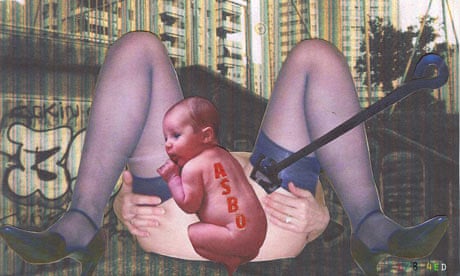Halfway between Liverpool Lime Street station and Norris Green, artist Joann Kushner pulls off the main road and points to a children's playground, a splash of colour beside the dark brick nursery to which it is attached.
"There's razor wire around it," she says. "That's an area where babies play. There's absolutely nothing that could be taken."
In a cafe on Norris Green's Broadway, Jack Flanagan, 17, fiddles with a tea stirrer. He doesn't go out much, he says, because he's tired of being stopped or moved on by the police. He has lost count of the number of times it has happened. "Over the last two or three years, if we go out on the street and we're not doing anything wrong, the police will just stop us and talk down to us, for no reason," he says.
"It could be up to three times a night. They ask for your name and address. They ask when you were last arrested, instead of just saying, 'Have you ever been arrested?' It's just assumed." Flanagan has never been arrested. He is studying for his A-levels, after getting the equivalent of 17 GCSEs, all of which are at least a C, and 10 of which are As or A*s.
Flanagan is one of 100 young people in Liverpool working with Kushner on Postcode Criminals, an arts project that uses film, photography and collage to explore the effect of stop and search, and antisocial behaviour legislation, on their lives and their relationships with their community.
This Friday eight early works from the project, photographic portraits that shimmer like old masters, will go on show at the new Museum of Liverpool. They will be added to National Museums Liverpool's collection of contemporary urban culture later in the year.
While 15- to 24-year-olds on Merseyside are creating dark, brooding pieces for Postcode Criminals, New York artist Dread Scott is working with young residents in Brownsville, Brooklyn, on their feelings of being "criminalised" by the city's zero tolerance policing. The two groups are sharing their thoughts via Skype and Facebook. Kushner wants to examine the idea that what happens in New York happens in a city like Liverpool 10 years later. "Community policing is just another form of zero tolerance," she says. "They use all the same tactics: stop and search, section 30 to disperse groups of three or more."
According to Scott, in a single year 700,000 people were stopped by police in New York City, and 88% of them were not arrested. As many as 93% of Brownsville residents were stopped.
The Guardian and the London School of Economics' Reading the Riots project found that anger at the way the police engage with communities was a significant cause of last summer's disturbances in England. In Liverpool, rioters seemed less interested in looting than battling with the police. Many of those interviewed said it is a response to distrust of Merseyside's notorious Matrix squad, which is responsible for much of the stop and search activity.
Bonds have been built quickly as the US and British groups discover their shared experiences. They will show their work simultaneously later in the year at the Liverpool Biennial and Rush Galleries in New York. Scott hopes that the collaboration will help them to create work that reaches not just their own communities but also a wider audience.
"I do think a lot of what's happening here in terms of criminalising youth is probably going to be implemented in England," he says. "If young people are completely isolated and just talking about it among themselves, as important as that is, it will just continue."
The early Postcode Criminals portraits are subtle, delicate works. Flanagan says he wanted to use the shades of light and dark on his subjects' faces to show that people are not always how they are perceived. But some of the later collages produced by the group are far harsher. Asbo Baby shows the spawn of a heels and stockings clad young woman, spreading her legs in front of a high-rise landscape.
"I wasn't expecting the work to be so graphic," Kushner admits. "Asbo Baby was done by a 17-year-old boy; that's real life experience."
Champion 800m runner and artist, Nzimah Akpan, 17, says the way police behave makes him angry, but also intimidates him. His friend and fellow artist Vithuran Rasashanikkam, 18, says he's been stopped just for wearing a hood, and told it makes him look "suspicious".
Flanagan senses the mistrust being fostered within his community. "I feel horrible when I see other people seeing me getting stopped," he says. "I know they think I've done something wrong. I hate it when you're in a group and an older person comes past and you can tell they're scared. You can sense it, that fear."

Comments (…)
Sign in or create your Guardian account to join the discussion